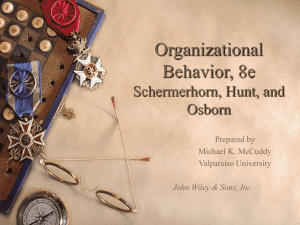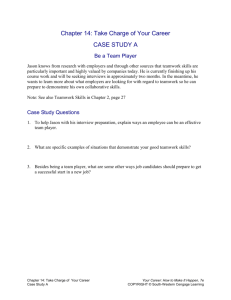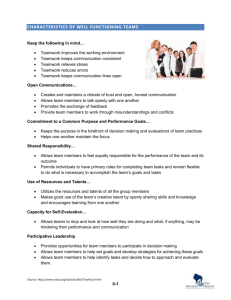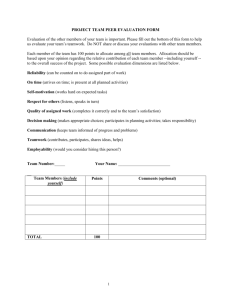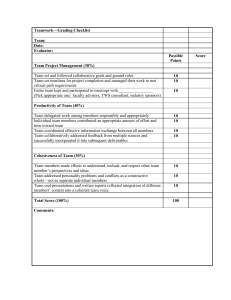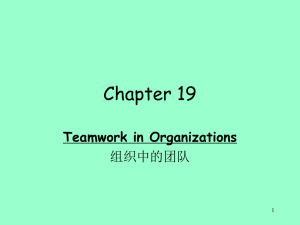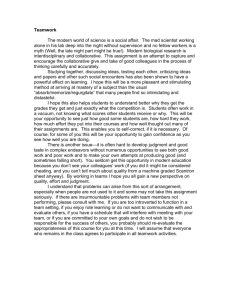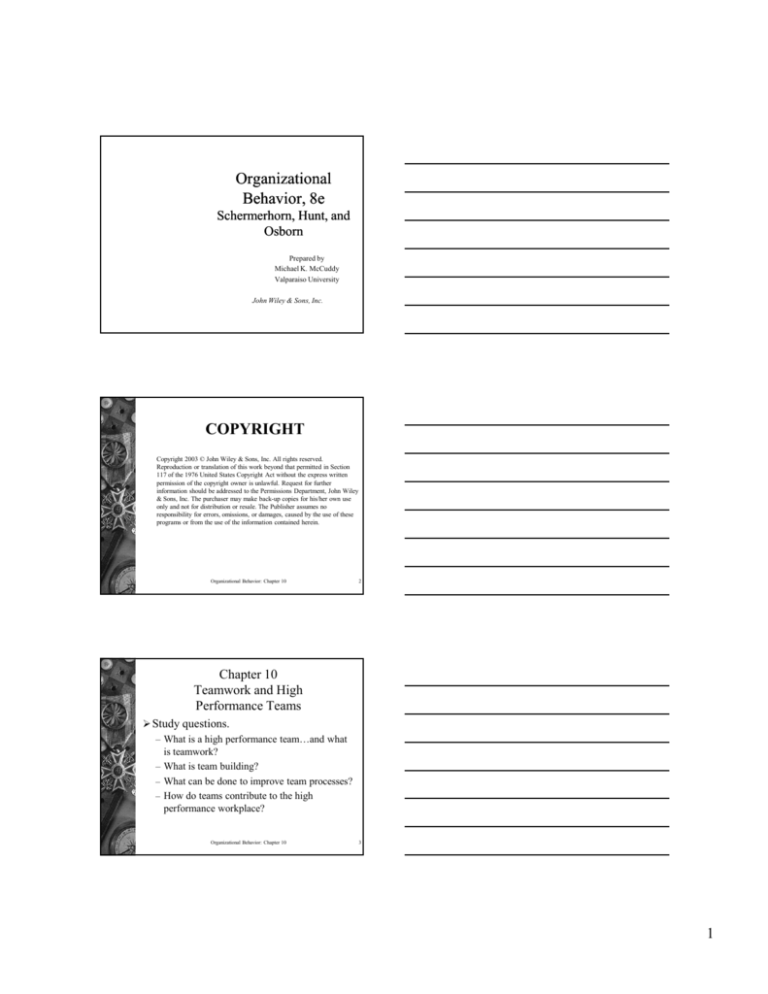
Organizational
Behavior, 8e
Schermerhorn, Hunt, and
Osborn
Prepared by
Michael K. McCuddy
Valparaiso University
John Wiley & Sons, Inc.
COPYRIGHT
Copyright 2003 © John Wiley & Sons, Inc. All rights reserved.
Reproduction or translation of this work beyond that permitted in Section
117 of the 1976 United States Copyright Act without the express written
permission of the copyright owner is unlawful. Request for further
information should be addressed to the Permissions Department, John Wiley
& Sons, Inc. The purchaser may make back-up copies for his/her own use
only and not for distribution or resale. The Publisher assumes no
responsibility for errors, omissions, or damages, caused by the use of these
programs or from the use of the information contained herein.
Organizational Behavior: Chapter 10
2
Chapter 10
Teamwork and High
Performance Teams
Study questions.
– What is a high performance team…and what
is teamwork?
– What is team building?
– What can be done to improve team processes?
– How do teams contribute to the high
performance workplace?
Organizational Behavior: Chapter 10
3
1
What is a high performance
team…and what is teamwork?
A team is a small group of people with
complementary skills, who work actively
together to achieve a common purpose for
which they hold themselves collectively
accountable.
Teams are one of the major forces behind
revolutionary changes in contemporary
organizations.
Organizational Behavior: Chapter 10
4
What is a high performance
team…and what is teamwork?
Types of teams.
– Teams that recommend things.
• Established to study specific problems and
recommend solutions to them.
– Teams that run things.
• Have formal responsibility for leading other
groups.
– Teams that make or do things.
• Functional groups that perform ongoing tasks.
Organizational Behavior: Chapter 10
5
What is a high performance
team…and what is teamwork?
The nature of teamwork.
– Team members actively work together in such
a way that all of their respective skills are
utilized to achieve a common purpose.
– Teamwork is the central foundation of any
high performance team.
Organizational Behavior: Chapter 10
6
2
What is a high performance
team…and what is teamwork?
Characteristics of high performance teams.
– High performance teams:
• Have strong core values.
• Turn a general sense of purpose into specific
performance objectives.
• Have the right mix of skills.
• Possess creativity.
Organizational Behavior: Chapter 10
7
What is a high performance
team…and what is teamwork?
Diversity and team performance.
– To create and maintain high performance
teams, the elements of group effectiveness
(Chapter 9) must be addressed and
successfully managed.
– Diverse teams:
• Improve problem solving and increase creativity.
• May struggle in the short term.
• Have strong long-term performance potential.
Organizational Behavior: Chapter 10
8
What is team building?
Team members and leaders must work hard to
achieve teamwork.
Team building helps in achieving teamwork.
Team building.
– A sequence of planned activities designed to gather
and analyze data on the functioning of a group and to
initiate changes designed to improve teamwork and
increase group effectiveness.
Organizational Behavior: Chapter 10
9
3
What is team building?
How team building works.
– Five step process.
• Problem or opportunity in team effectiveness.
• Data gathering and analysis.
• Planning for team improvements.
• Actions to improve team functioning.
• Evaluation of results.
Organizational Behavior: Chapter 10
10
What is team building?
Approaches to team building.
– Formal retreat approach.
• Team building occurs during an offsite retreat.
– Continuous improvement approach.
• The manager, team leader, or members take
responsibility for ongoing team building.
– Outdoor experience approach.
• Members engage in physically challenging
situations that require teamwork.
Organizational Behavior: Chapter 10
11
What can be done to improve
team processes?
Increased emphasis on teams and
teamwork:
– Presents challenges to people accustomed to
more traditional ways of working.
– Creates complications due to multiple and
shifting memberships.
– Requires team leaders and members to deal
positively with group dynamics issues.
– Requires ongoing team building.
Organizational Behavior: Chapter 10
12
4
What can be done to improve
team processes?
New member problems.
– New members are concerned about issues of:
• Participation.
• Goals.
• Control.
• Relationships.
Organizational Behavior: Chapter 10
13
What can be done to improve
team processes?
New member problems — cont.
– Behavior profiles of coping with individual
entry problems.
• Tough battler.
• Friendly helper.
• Objective thinker.
Organizational Behavior: Chapter 10
14
What can be done to improve
team processes?
Behavior profiles for coping.
– Tough battler.
• Is frustrated by a lack of identity in the new group.
• May act aggressively or reject authority.
• Seeks to determine his or her role in the group.
Organizational Behavior: Chapter 10
15
5
What can be done to improve
team processes?
Behavior profiles for coping — cont.
– Friendly helper.
• Is insecure, suffering uncertainties of intimacy and
control.
• May show extraordinary support for others, behave
in a dependent way, and seek alliances.
• Needs to know whether she or he will be liked.
Organizational Behavior: Chapter 10
16
What can be done to improve
team processes?
Behavior profiles for coping — cont.
– Objective thinker.
• Is anxious about how personal needs will be met.
• Acts in a passive, reflective, and even single-
minded manner.
• Concerned with fit between individual and group
goals.
Organizational Behavior: Chapter 10
17
What can be done to improve
team processes?
Task and maintenance leadership.
– High performance teams require distributed
leadership.
• The team leader and team members share in the
responsibility of meeting task needs and
maintenance needs.
Organizational Behavior: Chapter 10
18
6
What can be done to improve
team processes?
Task activities.
– The various things members do that contribute directly
to the performance of important group tasks.
– Task activities include:
• Initiating discussion.
• Sharing information.
• Asking information of others.
• Clarifying what has been said.
• Summarizing the status of a deliberation.
Organizational Behavior: Chapter 10
19
What can be done to improve
team processes?
Maintenance activities.
– Support the group’s social and interpersonal
relationships.
– Maintenance activities include:
•
•
•
•
Encouraging the participation of others.
Trying to harmonize differences of opinion.
Praising the contributions of others.
Agreeing to go along with a popular course of
action.
Organizational Behavior: Chapter 10
20
What can be done to improve
team processes?
Groups members should avoid the following
disruptive behaviors:
– Being overly aggressive toward other members.
– Withdrawing and refusing to cooperate with others.
– Horsing around when there is work to be done.
– Using the group as a forum for self-confession.
– Talking too much about irrelevant matters.
– Trying to compete for attention and recognition.
Organizational Behavior: Chapter 10
21
7
What can be done to improve
team processes?
Roles and role dynamics.
– A role is a set of expectations associated with
a job or position on a team.
– Performance problems occur when roles are
unclear or conflictive.
Organizational Behavior: Chapter 10
22
What can be done to improve
team processes?
Roles and role dynamics — cont.
– Role ambiguity — occurs when a person is
uncertain about his/her role.
– Role overload — occurs when too much is
expected and the person feels overwhelmed
with work.
– Role underload — occurs when too little is
expected and the person feels underutilized.
Organizational Behavior: Chapter 10
23
What can be done to improve
team processes?
Roles and role dynamics — cont.
– Role conflict — occurs when a person is
unable to meet the expectations of others.
– Forms of role conflict.
• Intrasender role conflict.
• Intersender role conflict.
• Person-role conflict.
• Interrole conflict.
Organizational Behavior: Chapter 10
24
8
What can be done to improve
team processes?
Norms:
– Represent beliefs about how group or team members
are expected to behave.
– Are rules or standards of conduct.
– Clarify role expectations.
– Help members to structure their behavior
– Help members to gain a common sense of direction.
– Help to reinforce group or team culture.
Organizational Behavior: Chapter 10
25
What can be done to improve
team processes?
Key norms that can have positive or
negative implications.
– Performance norms.
– Organizational and personal pride norms.
– High-achievement norms.
– Support and helpfulness norms.
– Improvement and change norms.
Organizational Behavior: Chapter 10
26
What can be done to improve
team processes?
Team cohesiveness.
– The degree to which members are attached to
and motivated to remain a part of the team.
Organizational Behavior: Chapter 10
27
9
What can be done to improve
team processes?
Members of highly cohesive groups:
– Value their membership.
– Try to maintain positive relationships with other
members.
– Are energetic when working on team activities.
– Are not prone to absenteeism or turnover.
– Are genuinely concerned about team performance.
– Tend to satisfy a broad range of individual needs.
Organizational Behavior: Chapter 10
28
What can be done to improve
team processes?
High team cohesiveness occurs when:
– Members are similar in age, attitudes, needs, and
backgrounds.
– Group size is small.
– Members respect each others’ competencies.
– Members agree on common goals.
– Members work on interdependent tasks.
– Groups are physically isolated from others.
– Groups experience performance success or crisis.
Organizational Behavior: Chapter 10
29
What can be done to improve
team processes?
Rule of conformity in group dynamics.
– The more cohesive the group, the greater the
conformity of members to group norms.
– Positive performance norms in a highly
cohesive group have a positive effect on task
performance.
– Negative performance norms in a highly
cohesive group have a negative effect on task
performance.
Organizational Behavior: Chapter 10
30
10
What can be done to improve
team processes?
Cohesiveness can be increased or decreased by
making changes in:
–
–
–
–
–
–
–
–
Group goals.
Membership composition.
Member interactions.
Group size.
Competition within and between teams.
Rewards.
Location.
Duration.
Organizational Behavior: Chapter 10
31
How do teams contribute to the high
performance workplace?
Problem-solving teams.
– Employee involvements teams include a wide
variety of teams whose members meet
regularly to collectively examine important
workplace issues.
– Quality circle.
• A special type of employee involvement team.
• Team meets periodically to address problems
relating to quality, productivity, or cost.
Organizational Behavior: Chapter 10
32
How do teams contribute to the high
performance workplace?
Cross-functional teams.
– Consist of members representing different
functional departments or work units.
– Used to overcome functional silos problem.
– Used to solve problems with a positive
combination of functional expertise and
integrative systems thinking.
Organizational Behavior: Chapter 10
33
11
How do teams contribute to the high
performance workplace?
Virtual teams.
– Members meet at least part of the time
electronically and with computer support.
– Groupware facilitates virtual meetings and
group decision making.
Organizational Behavior: Chapter 10
34
How do teams contribute to the high
performance workplace?
Key advantages of virtual teams.
– Brings cost effectiveness and speed to
teamwork.
– Brings computer power to information
processing and decision making.
Key disadvantage of virtual teams.
– Direct personal contact among members
suffers.
Organizational Behavior: Chapter 10
35
How do teams contribute to the high
performance workplace?
Self-managing teams.
– Small groups are empowered to make the decisions
needed to manage themselves on a daily basis.
– Teams make decisions on:
• Scheduling work.
• Allocating tasks.
• Training in job skills.
• Evaluating performance.
• Selecting new team members.
• Controlling quality of work.
Organizational Behavior: Chapter 10
36
12
How do teams contribute to the high
performance workplace?
How self-managing teams work.
– Are permanent and formal elements of the
organizational structure.
– Team members assume duties otherwise
performed by the manager or first-line
supervisor.
– The team should include between 5 and 15
members.
– Members rely on multiskilling.
Organizational Behavior: Chapter 10
37
How do teams contribute to the high
performance workplace?
Benefits of self-managing teams.
– Productivity and quality improvements.
– Production flexibility.
– Faster response to technological change.
– Reduced absenteeism and turnover.
– Improved work attitudes.
– Improved quality of work life.
Organizational Behavior: Chapter 10
38
How do teams contribute to the high
performance workplace?
Operational difficulties for self-managing
teams.
– Impact on supervisors and others accustomed
to a more traditional way of working.
– Self-managing teams are not appropriate for
all organizations.
Organizational Behavior: Chapter 10
39
13

